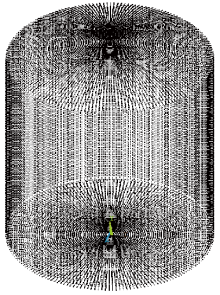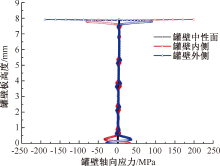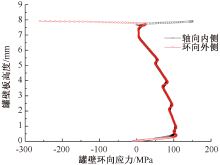| [1] |
石磊, 帅健, 许葵. 在役外浮顶储罐的强度评估方法[J]. 应用力学学报, 2020, 37(3):1350-1355,1410-1 411.
|
|
SHI Lei, SHUAI Jian, XU Kui. Strength assessment method for floating roof storage tank in service[J]. Chinese Journal of Applied Mechanics, 2020, 37(3): 1350-1355, 1 410-1 411.
|
| [2] |
苏文强, 陈志平, 马赫, 等. 地基不均匀沉降和风载荷联合作用下的大型储罐屈曲分析[J]. 压力容器, 2019, 36(3):35-43.
|
|
SU Wenqiang, CHEN Zhiping, MA He, et al. Buckling analysis of large storage tank under the combined action of uneven settlement and wind load of the foundation[J]. Pressure Vessel Technology, 2019, 36(3): 35-43.
|
| [3] |
夏燕. 风荷载作用下大型钢制储罐屈曲行为研究[D]. 重庆: 西南石油大学, 2018.
|
|
XIA Yan. The study about the wind-induced of the large steel tanks[D]. Chongqing: Southwest Petroleum University, 2018.
|
| [4] |
王莉莉, 付世博, 乔宏宇, 等. 立式储罐静力分析的简化有限元模型[J]. 油气储运, 2021, 40(1):51-57.
|
|
WANG Lili, FU Shibo, QIAO Hongyu, et al. Simplified finite element model for static analysis of vertical storage tank[J]. Oil & Gas Storage and Transportation, 2021, 40(1): 51-57.
|
| [5] |
石磊, 帅健, 王晓霖, 等. 地基沉降对石油储罐象足屈曲的影响[J]. 中国安全科学学报, 2018, 28 (9):56-61.
doi: 10.16265/j.cnki.issn1003-3033.2018.09.010
|
|
SHI Lei, SHUAI Jian, WANG Xiaolin, et al. Effect of foundation settlement on elephant foot buckling of oil tank[J]. China Safety Science Journal, 2018, 28(9): 56-61.
doi: 10.16265/j.cnki.issn1003-3033.2018.09.010
|
| [6] |
马尚. 地基不均匀沉降下含缺陷储罐结构屈曲和安全评价[D]. 北京: 中国石油大学(北京), 2021.
|
|
MA Shang. Buckling and safety evaluation of storage tank with defects under uneven settlement of foundation[D]. Beijing: China University of Petroleum (Beijing), 2021.
|
| [7] |
赵慧磊, 钱才富. 大型储罐外压稳定性[J]. 辽宁工程技术大学学报:自然科学版, 2009, 28(增2):280-282.
|
|
ZHAO Huilei, QIAN Caifu. Stability of large storage tank subjected to external pressure[J]. Journal of Liaoning Technical University: Natural Science, 2009, 28(S2): 280-282.
|
| [8] |
胡明磊, 张维, 尚宪和. 核级大型储罐屈曲状态下的复原技术探讨[J]. 中国核电, 2020, 13(2):227-233.
|
|
HU Minglei, ZHANG Wei, SHANG Xianhe. System solution for the buckling state of nuclear-scale large storage tanks[J]. China Nuclear Power, 2020, 13(2): 227-233.
|
| [9] |
邢述, 杜邦胜, 都亮, 等. 空间数据扫描技术在大型常压储罐变形检测中的应用[J]. 无损检测, 2022, 44(10):20-24.
doi: 10.11973/wsjc202210005
|
|
XING Shu, DU Bangsheng, DU Liang, et al. Application of spatial data scanning technology in large atmospheric storage tank deformation detection[J]. Nondestructive Testing, 2022, 44(10): 20-24.
doi: 10.11973/wsjc202210005
|
| [10] |
郭洪, 李修能, 都亮, 等. 常压储罐壁板变形检测方法探讨[J]. 中国特种设备安全, 2022, 38(8):43-46,54.
|
|
GUO Hong, LI Xiuneng, DU Liang, et al. Discussion on deformation detection method of atmospheric storage tank shell[J]. China Special Equipment Safety, 2022, 38(8): 43-46, 54.
|
| [11] |
YOUNG H J, SEONGHYUK H. Three-dimensional digital documentation of cultural heritage site based on the convergence of terrestrial laser scanning and unmanned aerial vehicle photogrammetry[J]. ISPRS International Journal of Geo-Information, 2019, 8(2): 53-59.
|
| [12] |
BAI Yun, YANG Chaozhi, LI Guanlin, et al. Point-GSMAE: a graph convolution and scale-based masked autoencoder for 3D point cloud representation[J]. Information Sciences, 2025, 719: DOI: 10.1016/j.ins.2025.122474.
|
| [13] |
YUE Hongzhe, WANG Qian, ZHANG Mingyu, et al. 2D-3D fusion approach for improved point cloud segmentation[J]. Automation in Construction, 2025, 177: DOI: 10.1016/j.autcon.2025.106336.
|
| [14] |
张强. 基于激光视觉融合与深度学习的点云重建技术研究[D]. 重庆: 重庆理工大学, 2024.
|
|
ZHANG Qiang. Research on point cloud reconstruction technology based on laser vision fusion and deep learning[D]. Chongqing: Chongqing University of Technology, 2024.
|
| [15] |
周保兴, 王兵, 张航钒, 等. 融合多源空间数据的复杂场景真三维模型构建方法[J]. 测绘通报, 2024(4):13-17.
doi: 10.13474/j.cnki.11-2246.2024.0403
|
|
ZHOU Baoxing, WANG Bing, ZHANG Hangfan, et al. A method for constructing true 3D models of complex scenes based on multi-source spatial data[J]. Bulletin of Surveying and Mapping, 2024(4): 13-17.
doi: 10.13474/j.cnki.11-2246.2024.0403
|
| [16] |
廖岳, 李汉涛, 刘界鹏, 等. 基于点云数据和启发式算法的复杂龙骨:面板结构智能数字化施工方法[J/OL]. 土木与环境工程学报:1-11. [2024-01-29]. http://kns.cnki.net/kcms/detail/50.1218.TU.20240125.1826.002.html.
|
|
LIAO Yue, LI Hantao, LIU Jiepeng, et al. Intelligent digital construction for complex frame-panelstructures based on point cloud data and heuristic algorithms[J/OL]. Journal of Civil and Environmental Engineering:1-11.[2024-01-29]. http://kns.cnki.net/kcms/detail/50.1218.TU.20240125.1826.002.html.
|
| [17] |
GB 50009—2012, 建筑结构载荷规范[S].
|
|
GB 50009-2012, Load code for the design of building structures[S].
|
| [18] |
GB/T 4732.4—2024, 压力容器分析设计第4部分:应力分类方法[S].
|
|
GB/T 4732.4-2024, Pressure vessels design by analysis part 4: stress classification methods[S].
|





















